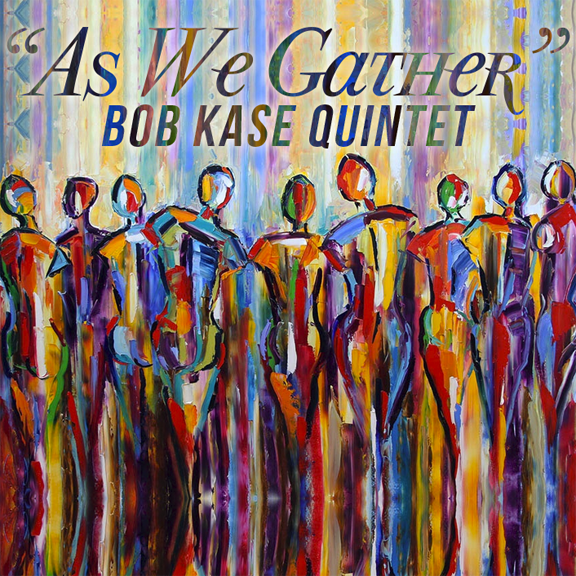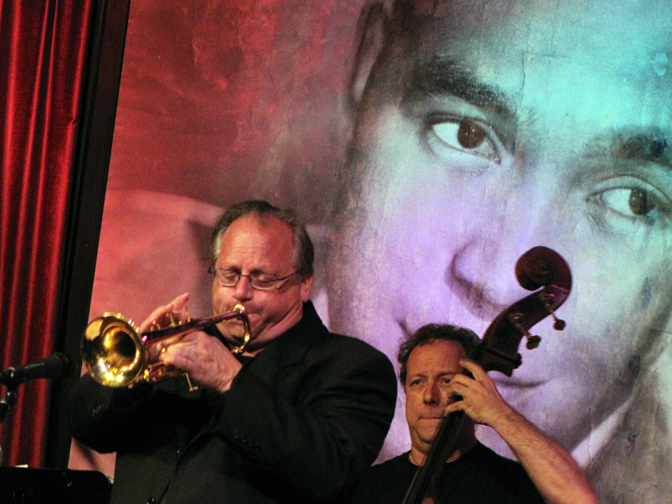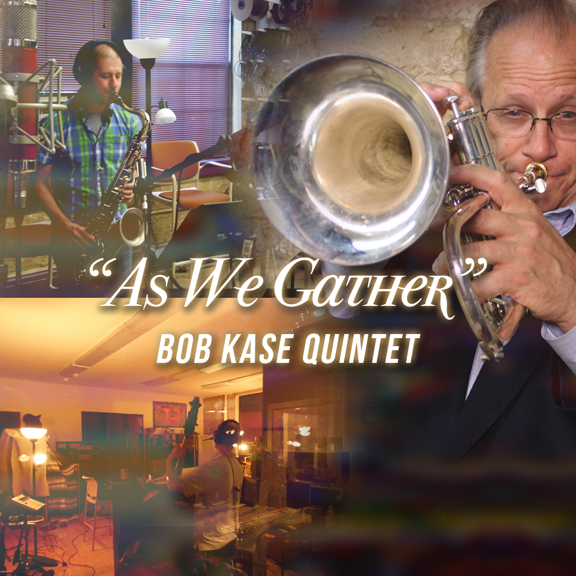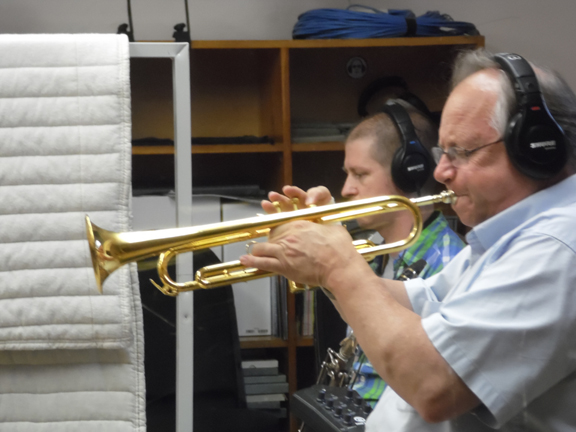Bob Kase has been developing a distinct relationship with Jazz music as an artist and educator for more than 40 years. Recently, the COMP Magazine caught up with Kase to discuss his rich history, what he values in creating music, his new release “As We Gather”, and why the fine arts continue to be a valuable tool in the educational experience.

Bob Kase, As We Gather, Altenburgh Jazz Records, 2015
It is the journey of my career. I started playing professional trumpet in High School in small jazz groups and rock bands in New York. Upon graduation I received a call to play in the trumpet section of the backup band for Sonny and Cher, who were on top of the pop scene in those days. The lead player cut his lip and I moved over and covered his part. They asked me to finish the rest of the tour, so I did and it was the beginning of my professional career. After the tour ended I returned to college and played in all kinds of bands, jazz groups, rock bands, horn bands, polka bands, and Vegas shows, like Wayne Newton, Debby Reynolds, Dolly Parton, Sammy Davis Jr., the Temptations, The Supremes and a whole host of celebrity names that were still big in the 70’s. During college I played 5 – 6 nights a week.
After graduation I attended North Texas State University 1974-75, and worked all over Dallas. I got on the house band at the Venetian Room at the Fairmont Hotel, where I played with a celebrity every week. It was a great gig. The orchestra was led by a giant from the big band era, Jerry Gray. He was the staff arranger for the Glenn Miller band back in the 1930’s and 40’s. He wrote the charts for “In the Mood, Little Brown Jug, Moonlight Serenade” all huge hits during WWII. It was quite an education. We did a short tour with Stan Kenton’s band through Mexico that summer.
In 1975 I landed in Minneapolis to teach school, but ended up playing every night. I got busy doing studio work during the day. Rock Star, Prince, opened his recording studio in 1980, and the entire city became a recording hub then. I was in the studios recording most every day from 1982-1987. We recorded jazz, rock, pop, symphonic, jingles, movie sound tracks, you name it. I learned so much. During that time I also began doing educational clinics on trumpet performance for the Yamaha Corporation. Their endorsement sent me across the nation doing workshops, clinics, and solo performances with jazz ensembles, concert bands, and symphony orchestras all over the country. In 1984 I put together my first professional jazz quintet and recorded my first record, No Time For Daydreams. We did a national tour for 6 weeks playing one nighters from Minneapolis to L.A. Fun but exhausting. The Album did pretty well and put me on the map as a national artist.
After that, the recording industry began to change and I decided I wanted get off the road and to move into more academia, so I completed my Doctorate in Music while working full time. In 1987 I began my career as Professor of Trumpet at the University of Wisconsin-Stevens Point. I also left Yamaha and moved to the Edwards Trumpet Corporation. They sponsored my performances at a more international level, doing several European tours each year. I recorded two more CD’s, the first in 1993 – Weaver of Dreams, which really did quite well and garnered several major reviews including the New York Times. The next in 1999 – Those Paris Nights, and then a 3rd – Live at the Montreux Jazz Festival, in Switzerland.
After that, I felt I had built a successful jazz program and had won the major awards for the program and hired 5 full time jazz faculty, so it was time for another adventure. I signed with the Schilke Music Corporation for sponsorship and started working in Sweden, Norway, and Denmark quite a bit. I also moved into Academic Administration by becoming Director of the School of Music at UWSP. In 2007, after achieving my goals in that role I moved on to further administrative pursuits which brought me to becoming Dean at USF. I continued to perform in the Chicago Area and with the development of the DARA program, I decided it was time to document my compositions and new sounds with my new quintet, and thus came “AS WE GATHER.”

Bob Kase at the Jazz Showcase, Chicago, Illinois, 2015
Photo credit: Chester Alamo-Costello
What do you value in the process of creating music?
Music is my vehicle for creating art. However, creating is the most important part, whether it be in writing, painting, sculpting, whatever…. I have a need to create music. It is an art, but it is also a craft and it has to be practiced. I try to write all the time. I’d like to say everyday, but my position doesn’t afford me that kind of time. But, I try to write, write, write. Just sit down and write. There is no perfect way to do it. Sometimes it is agonizing work, other times it just flows. Nothing makes me more creative than a deadline or a commission. But I write music all the time. I love it! It makes me grounded and helps me in all other aspects of my career. It makes creative problem solving flow. As, I said, it is a craft too, and I never stop practicing composing. 80% of what I write is junk, that 20% of gold keeps me going. Some say there is no such thing as writing, only re-writing, and there is a lot of truth to it. I may write a work in a short amount of time and then spend months working it over and over and over. Once in a while, it just comes out and works, but that is very rare. Not every good piece of music is a masterpiece. I love writing incidental music, pop music, jazz, classical, hymns. For many years I would write a short hymn everyday just to work the harmonic concepts. I still try to write a little counterpoint each day just to keep the techniques up. I wrote the USF Alma Mater in minutes, but spent weeks tweaking it.

Bob Kase, As We Gather, Altenburgh Jazz Records, 2015
You have a new release, “As We Gather”, released by Altenburgh Records this past spring. Can you share with us the process for creating this record?
I had amassed a pretty significant collection of jazz tunes that I really wanted to document before my career waned too much. I shared these pieces with several different combinations of jazz musicians and they encouraged me to perform them. So, with the DARA studio opening, Jeff Jaskowiak encouraged me to do a CD in the new studio. So I did. I called my top Chicago guys and we spend two 3 hours sessions laying down 10 new pieces they had never played before. It was fresh and popping. Alby Odem was phenomenal in working some magic to edit, mix and master the recording.
Jazz music continues to have a widespread influence on numerous music genres. You see references in Rap, Alternative, House, and Electronic music regularly. Why do you think Jazz still holds such resonance with such a diverse audience?
Jazz is a uniquely American art form that embraces the harmonic complexity of European classical music, the rawness of rural African/American blues, and the sophistication of modern performance standards, and the creativeness of spontaneous composition. It is the history of American 20th Century music. Now it has followed its natural DNA of infusing influences from all forms, styles, and nationalities into its polyglot of music. It has become the American Classical Music, to which America today is abandoning, but the rest of the world is embracing. Jazz is far more popular in Asia, Europe, Africa, Australia, almost anywhere in the world than in the USA. It is embraced as a sophisticated art form and it now influences all music around the world. There are 10 times more jazz recordings sold in Japan than the U.S. Jazz is now only 3% of recorded music today in America, and unfortunately today’s youth is not continuing to embrace it. Which is hard to understand since nearly every high school and college in America has a jazz studies program, yet, we are not producing a jazz audience that will survive the next generation. Jazz is embraced all over the world, but it is dying in the U.S. Even Chicago’s own single remaining jazz radio station has moved over to offer folk music at night instead of jazz. There is no shortage of great jazz musicians all over the world. I was in Russia, and I heard a big band in Moscow that was just as good if not better than our Jazz at the Lincoln Center Orchestra. It is thriving all over the world, except here. It only makes sense that jazz musicians will influence all other forms of music and art.
Why is music and other fine arts important to the educational experience?
A truly educated person must be able to express themselves aesthetically. That is why music was one of the original seven liberal arts. Music and visual art is about expressing oneself aesthetically. Music is perhaps one of the most powerful aesthetics we know. To make my point, try listening to a movie without a sound track. I have seen what music does to people. Take a bunch of chubby 60 year old Americans and just start the introduction to “My Girl”, or play “Celebrate” to those who grew up in the 70’s. Those people instantly turn into 16 year olds again. I have seen 75 year old men weep like babies when they hear a beautiful opera soprano sing O’ Mio Babbino Caro, and I have seen crippled wheel chaired women get up and dance to “Green Eyes”. I have seen the power of music and what it stirs in the human soul. There has not been a civilization that has not contributed to their culture without music. It is the aesthetic identity to which each person, whether they know it or not, clings to, and is move by. If people don’t get it in their educational institutions, they will find it elsewhere or they will become culturally stunted. No civilization can survive being culturally stunted.

Bob Kase in studio, 2015
What else do you have planned for 2015 and beyond?
I am still performing weekly with local jazz groups. I have composed a Jazz Mass a few years back and I am still refining it and hopefully will get it performed someday. It is a huge work, for full jazz orchestra, full choir, and soloists, so it will be quite a production. Those to whom I have share it say it is a very powerful and emotional work, so my goal is to one day share it in its entirety.
I also want to return to writing music for young musicians. I have started enjoying writing choral music and vocal music, so maybe I will do something in that vein for a while. That is the challenge! So much music to write, and so little time.
For addition information on Bob Kase and his music, please visit:
Bob Kase on Altenburgh Jazz – http://www.altenburgh.com/bob-kase.html
Bob Kase on Really Good Music – http://www.reallygoodmusic.com/rgm.jsp?page=composers2&compid=127082
Bob Kase on Schilke Music – http://www.schilkemusic.com/robert-kase/
Interview by Chester Alamo-Costello


